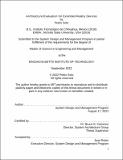Architecture Evaluation for Extended Reality Devices
Author(s)
Soto, Pedro
DownloadThesis PDF (3.105Mb)
Advisor
Cameron, Bruce G.
Terms of use
Metadata
Show full item recordAbstract
Many technology companies have initiated significant efforts with digital transformation for their enterprises to satisfy current business needs and reach out to larger markets such as investments in Intelligent platforms (Cloud & AI), Intelligent automation (RPA), Internet of Things (IoT). VR/AR/MR technologies are also considered part of this digital transformation, specifically by the use of hand gestures, voice, hand controllers, and gaze to control the projection of experiences in the Augmented, Virtual, and Mixed Reality worlds.
There are many product designs and potential manufacturing improvements for creating head-mounted devices. However, the best product architecture and “go to market” approach is still unclear to the industry.
Microsoft with HoloLens has a complex architecture with a high-quality immersion experience, focusing on the enterprise and government markets with sophisticated healthcare, manufacturing, and military/defense applications. However, their initial price to market is way above their competitors. Meta with Oculus has focused their efforts on consumer electronics with gaming applications. Others such as Magic Leap, Samsung with Gear VR, HTC Vive, Google Cardboard, Google Lens, Sony with PlayStation VR controllers, and Apple with AR glasses have interesting product proposals in retail, advertising, education, gaming, and social media environments.
This thesis analyzes product design and functionalities strategies for XR Head-Mounted devices, evaluates a broad range of variables, and suggests a range of architectures that could meet users' future market needs. The result of this analysis is summarized in two main architectures; Spiral #1: Stable Intermediate Use Case and Spiral #2: Future Use Case. Spiral #1 is an excellent option to use as a stable intermediate architecture; it minimizes downside while capturing upside opportunities in size, comfort, and cost until Spiral #2 can be fully implemented.
Date issued
2022-09Department
System Design and Management Program.Publisher
Massachusetts Institute of Technology